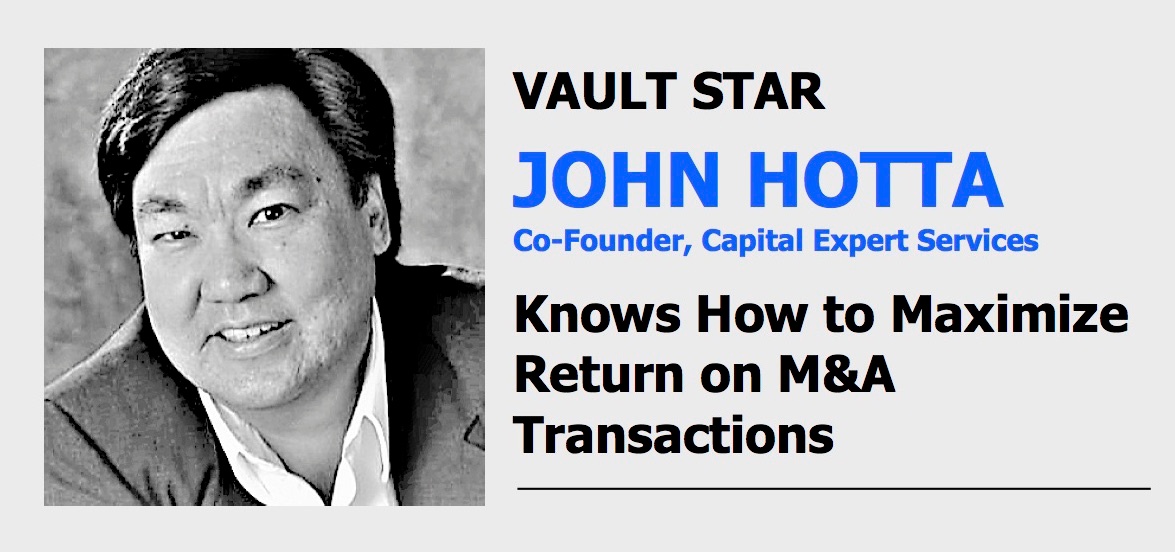M&A Value Creators & Destroyers
07 June, 2020
In today’s digital economy, technology and talent drive business performance. That’s why these two dimensions are so critical to maximizing the return on any M&A transaction.
On June 21st, ShareVault hosted a web panel discussion moderated by James O’Gara, CEO and Founder of OnMessage. James was joined by Aaron Belcher, Founder of APB Law, and John Hotta, Co-Founder and Senior Advisor at Capital Expert Services, LLC. The discussion, “M&A Integration: Maximizing Return on Technology and Talent,” focused on addressing the critical decisions related to technology and talent that can either create or destroy M&A value in the due-diligence and integration process.
As a prelude to the web panel discussion, we sat down with John Hotta to find out what he believes are the major pitfalls and best practices for M&A due diligence and integration.
Q: What is the biggest mistake due diligence or integration teams make when it comes to technology and talent?
 John: I think the biggest mistake people make during due diligence and integration is making promises or commitments that are unrealistic. It’s human nature to want to believe that everything will work out for the best, but the reality is that during M&A there are many moving pieces that are changing on a daily basis. The due diligence team may want to ensure that they intend to keep the target company’s sales team on, and indeed, that may be part of their strategy, but deal terms can change and that strategy can change. Your vision for the transaction and the actual transaction can be very different things. So, don’t make promises you can’t keep. There are certainly a handful of people you know you will hold onto, but those are very targeted and specific. You can’t make that kind of promise for an entire organization.
John: I think the biggest mistake people make during due diligence and integration is making promises or commitments that are unrealistic. It’s human nature to want to believe that everything will work out for the best, but the reality is that during M&A there are many moving pieces that are changing on a daily basis. The due diligence team may want to ensure that they intend to keep the target company’s sales team on, and indeed, that may be part of their strategy, but deal terms can change and that strategy can change. Your vision for the transaction and the actual transaction can be very different things. So, don’t make promises you can’t keep. There are certainly a handful of people you know you will hold onto, but those are very targeted and specific. You can’t make that kind of promise for an entire organization.
Q: What is the leading value destroyer during M&A due diligence or integration?
John: The biggest value destroyer is when an organization takes on parts of the target company that they don’t need. It’s important to focus on what adds value and what creates synergy. If a facet of the organization is not doing that, then it very well may be doing the opposite.
It’s important to recognize that after a transaction there’s a new company and that company is going to adopt the acquiring company’s processes in their culture. Melding of cultures doesn’t really work. The acquiring company needs to make it clear to people that if they are going to be part of the acquiring company then they are going to be a part of the acquiring company’s culture.
This goes for other assets as well. It’s important to evaluate IP,manufacturing processes, and facilities and focus on what is really needed by the new company. That’s vital. The mistake too many acquiring companies make is taking on too many parts and people from the target company.
I get into more detail of additional value creators and destroyers in this web panel discussion.
Q: What are best practices when selecting a due diligence team?
 John: The two most important qualifications for a due diligence team is experience and consistency. When you have the same team doing multiple rounds of due diligence on multiple companies, that team gets very good at what they’re doing. They learn to spot things they hadn’t noticed before. They learn to ask the right questions, listen and follow up appropriately. That experience is critical. If the team is inexperienced then it’s important to hire a consultant that has that experience.
John: The two most important qualifications for a due diligence team is experience and consistency. When you have the same team doing multiple rounds of due diligence on multiple companies, that team gets very good at what they’re doing. They learn to spot things they hadn’t noticed before. They learn to ask the right questions, listen and follow up appropriately. That experience is critical. If the team is inexperienced then it’s important to hire a consultant that has that experience.
Q: What are some tips for getting leadership buy in and backing during a deal?
John: I would say there are two things: one is tangible, the other is a little less so. The tangible one is understanding what the compensation for the C-level team and for the board of directors will be. Money solves a whole host of issues and is by far the biggest driver.
The second is something I will call “future aspirations.” In particular, what are the future aspirations of the C-level executives or board members? What sort of future do they see for themselves with the new company? Do they aspire to remain with the acquiring company? Or are they planning to move to a South Seas island? Having an understanding of that prior to due diligence is ideal. You should at least have a sense of what the C-level people are thinking. The C-level team is the gatekeeper of the board. If you understand their aspirations, it will be easier to gain approval from the board for the deal.
Q: What is the value of having an M&A integration web panel discussion with legal, business, governance, technical and messaging/communication experts on hand?

Each of us bring an abundance of real-life experience with merger and acquisition due diligence and integration. We’ve consulted with companies across industries for decades and know what to watch out for and how to increase the value of an M&A. We’ve had enormous success and we’ve also had failures – sometimes the best educational nuggets come from lessons learned because we can offer advice on what to watch out for based on personal experience. Just as it’s important to select people who’ve been through a merger or acquisition to be on the due diligence and integration team – it’s important to leverage common experience to ensure that you know what to watch our for and don’t overlook something that can turn into a value destroyer during M&A.
Q: What value does Capital Expert Services provide to its clients?
John: CapEx has created the Capital Expert Registry™, a pool of more than 200 hand-picked subject-matter experts. With this registry CapEx is able to quickly connect SMEs (Small and Medium Sized Enterprises) and global professional-services firms to industry experts in fields considered most critical in business transactions to help them address the increasingly complex challenges of M&A, legal cases and other corporate initiatives.
Q: What role do you play there?
John: I primarily speak to boards and to C-level suites about strategy and what their roles should be. Boards should be focused on high-level strategy and evaluating the transaction. Management’s role is more focused on details and execution. So, I talk about roles as well as cybersecurity and what issues to look out for.
To view the on-demand web panel discussion click here.
